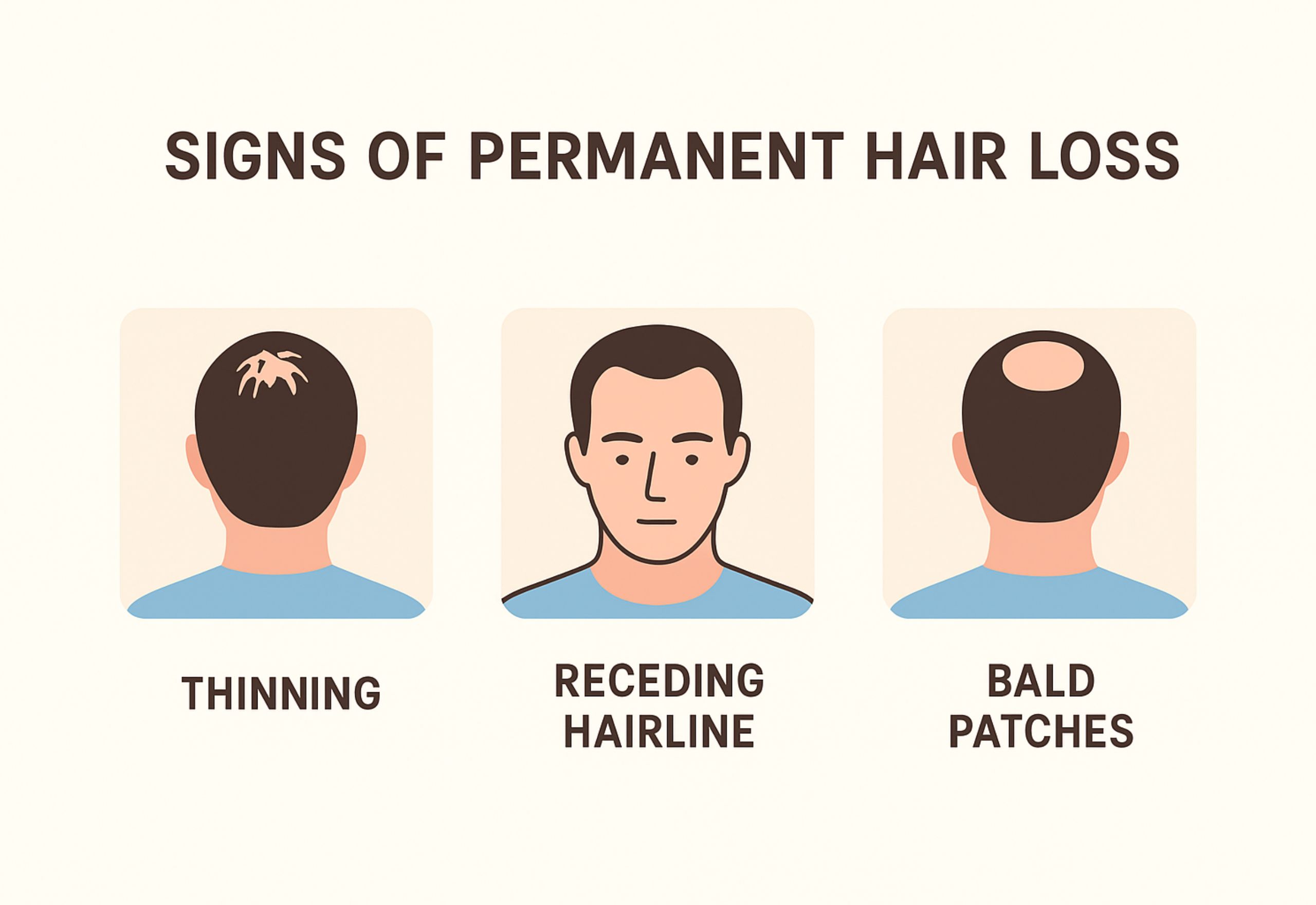Hair has always been considered a mirror of beauty, good health, and self-confidence. That’s the reason even minimal thinning or a few fallen hairs can sometimes cause a panic reaction. However, not all hair loss is a sign of permanent damage. In some cases, the person could be going through temporary shedding, hormonal changes, or just hair breakage without knowing. Nevertheless, there are times the hair loss becomes permanent, and being able to identify the changes at an early stage can greatly affect treatment and long-term care.
This blog will help you learn the signs of permanent hair loss, talking about how they differ in Breakage, causes, and what you can do if the hair is not growing back. If you are in the stage of early symptoms or have been shedding for a long time, knowing these signs will help you decide the next step to take in order to get healthy hair.
Why It Is Important to Know About Permanent Hair Loss
Quite a number of people mistake temporary shedding and breakage for permanent conditions. As a result, they are diagnosed late, and the recovery options become very limited. The main thing is to separate those characteristics which are assumed to be hair breakage, and actually are signs of permanent hair loss.
- Hair breakage most of the time is a result of weakened strands due to over-heating, chemical treatments, or the insufficient supply of moisture. In such cases, the affected hair usually appears uneven and shorter.
- Permanent hair loss is that which occurs when hair follicles become shrunken, weak or are totally destroyed, thus no hair is going to grow back. This kind of loss is more gradual and may need the help of a medical professional.
Recognizing the exact situation that applies to you aids in deciding the appropriate action; it could be that of strengthening your strands, making a visit to a dermatologist, or thinking about the use of advanced treatments.
Common Signs of Hair Breakage
Before we get into permanent hair loss, let’s go through some of the signs of hair breakage, because they are frequently mistaken for something much worse:
- Uneven strand length: You might also see a lot of short, broken hairs at the top of your head or ends.
- Frizz and split ends: Hair becomes unruly, looks dehydrated, and gets tangled easily.
- Breakage after styling: The application of heat or the use of tight hairstyles results in the breaking of the hair.
- White dots at the ends: These are the places of the breakdown of the hair structure from which the hair has detached.
Contrary to permanent hair loss, breakage is a condition that can be alleviated with the use of moisturizers, mild styling options, and the avoidance of too many chemical treatments.
Key Signs of Permanent Hair Loss
It is very important to recognize the signs of permanent hair loss so that early intervention can be done. This condition, unlike breakage, is progressive and, as such, it does not get better on its own.
1. Gradual Thinning Across the Scalp
Gradual thinning around the crown or the hairline is one of the earliest signs of the condition. The change is quite different from sudden shedding. The scalp can be visible in some areas where the density of hair has decreased.
2. Receding Hairline
A receding hairline is usually the first sign of permanent hair loss in men. The temples slowly move back, thus the hairline gradually recedes. On the other hand, the manner of hair loss in women may be the broadening of the part or the thinning of the area adjacent to the forehead.
3. Bald Patches
Permanent hair loss is often accompanied by the appearance of circular or patchy bald spots. The patches may even look smooth, and you might notice little or no regrowth after some time.
4. Miniaturized Hair Strands
As a follicle weakens, the hair that is produced will be thinner and shorter than before. Eventually, these miniaturized hairs become non-growing, causing a thinning that is visually noticeable.
5. Lack of Regrowth After Shedding
In case hair that has fallen is still not replaced after a few months, it is very likely that the follicles have become inactive. Shedding of a temporary nature is quite different because new hair always takes the place of the old one within the growth cycle.
6. Increased Scalp Visibility
When the scalp is more visible than before through the hair you have been caring for regularly, the reason might be permanent thinning of the hair rather than just breakage, which occurs at the surface of the hair.
7. Progressive Worsening Despite Care
Unlike breakage, permanent hair loss that keeps getting worse even with the use of protective measures such as conditioning and less styling is the case. This stubbornness is a sign of a more serious problem in the follicle.
Causes Behind Permanent Hair Loss
Understanding the causes behind signs of permanent hair loss is essential for prevention and management. The most common reasons include:
- Genetic (Androgenetic Alopecia): The main reason for hair loss is the inheritance of genes from family that cause the thinning of patterned hair.
- Hormonal Imbalances: The occurrence of PCOS, thyroid dysfunction, or menopause can lead to the shrinkage of hair follicles.
- Aging: The process of natural aging with the passage of time reduces follicle activity and causes thinning and baldness.
- Scarring conditions: Some autoimmune disorders, including alopecia areata or infections of the scalp, can cause permanent damage to follicles.
- Medical Treatments: Chemotherapy or radiation can sometimes be associated with irreversible loss; this will depend upon the dosage and the individual.
- Stress and lifestyle: Severe or chronic stress can initially provoke temporary shedding of permanent conditions; however, if severe and chronic, such stress can exacerbate the condition.
Differentiating Between Breakage and Permanent Hair Loss
It’s easy to confuse the two, but a closer look helps:
- Texture and Look: Breakage makes hair look frizzy and uneven. Permanent loss makes hair look thin and sparse.
- Location: Breakage often affects the ends, while permanent loss begins at the roots.
- Regrowth: Broken hair eventually grows back; permanently lost hair does not.
- Scalp Condition: Bald patches or thinning scalp indicate permanent issues, not surface damage.
Knowing this difference ensures you don’t waste time treating breakage when you should be seeking medical care for hair loss.
How to Respond to Signs of Permanent Hair Loss
Identifying early signs of permanent hair loss allows you to take appropriate action. This is how you should act:
1. Seek Professional Diagnosis
Dermatologists can perform scalp analysis, blood tests, and biopsies to confirm whether your condition is temporary or permanent.
2. Explore Medical Treatments
- Minoxidil: Usually advised to reactivate the growth of the hair in the areas that are thinning out.
- Finasteride (for men): Reduces hormone-related loss.
- Corticosteroids: Helpful in autoimmune-related bald patches.
3. Consider Non-Surgical Options
Some innovative treatments, such as low-level laser therapy (LLLT), platelet-rich plasma (PRP), or peptide-based formulations, may not only stop the loss but also stimulate the regrowth of the rejuvenated follicles.
4. Lifestyle Adjustments
- Eat a protein- and vitamin-rich diet.
- Manage stress with relaxation practices.
- Do not use too much heat or the wrong hair products on your hair.
5. Hair Restoration Surgery
In severe situations, where hair follicles have gone completely inactive, the surgical hair transplant might be a permanent method of solving the problem.
Lifestyle Tips to Reduce the Risk of Permanent Loss
Even if genetics plays a role, healthy habits can minimize the severity of the signs of permanent hair loss:
- Balanced Diet: Include iron, zinc, and omega-3 fatty acids.
- Gentle Care: Choose a shampoo that is sulfate-free and do not wash your hair too often.
- Protective Styling: Having your hair tied up loosely is a good way to avoid the pulling of the hair follicles.
- Hydration: Make sure both your scalp and body are well-hydrated.
- Sleep and Stress Management: Getting enough rest is a great source of energy for the whole body, including the hair follicles.
Quick Fixes for Immediate Confidence
If you can already see thinning hair, you can still make improvements to your overall look while figuring out the long-term solution:
- Use volumizing shampoos and conditioners.
- Consider hairstyles that create fullness (layered cuts or with texture and waves).
- Consider fibers or concealers to cover thin patches.
- Wear scarves, hats, or wigs for instant coverage when needed.
These won’t reverse the problem, but can boost self-confidence as you explore medical options.
Conclusion
Hair concerns are common, but the ability to recognize whether you’re dealing with signs of hair breakage or true signs of permanent hair loss makes all the difference. Breakage usually improves with simple care, while permanent loss requires medical attention and lifestyle changes.
If you are experiencing hair thinning over time, hairless areas, or no hair growth, then you need to talk to a professional without any further delay. Consequently, recognizing the problem early can contribute to slowing down the progression, controlling the symptoms, and, in most cases, saving the hair already there. The correct strategy, nutrition, gentle care, and high-end medical solutions can make your hair healthier and denser, thus keeping it fuller for a long period of time.
Related FAQs
Q. What is the difference between hair breakage and permanent hair loss?
Breakage usually involves the hair shaft, so the hair becomes uneven and frizzy, while permanent hair loss is a change in the follicle resulting in thinning and baldness.
Q. What are the early signs of permanent hair loss?
The main symptoms are thinning over time, receding hairline, areas of baldness, and less new hair growth.
Q. Can hair breakage turn into permanent hair loss?
It cannot happen directly, but continuous breakage ruins the hair’s health and can be the reason for the progression of the already existing hair loss situation.
Q. How do I know if I will recover from shedding?
If it grows back within a few months, it was temporary. If regrowth is missing, then the problem is most likely permanent.
Q. What role does diet play in preventing permanent hair loss?
A nutrient-rich diet with proteins, vitamins, and minerals strengthens follicles and delays thinning.
Q. Are bald patches always a sign of permanent loss?
Not necessarily! Some bald patches could regrow if caused by temporary conditions. Just make sure shiny bald patches typically indicate prevention is not going to happen.
Q. Can stress cause permanent hair loss?
Stress typically causes temporary shedding, but chronic stress may worsen hereditary conditions, making loss permanent.
Q. What treatments are available for permanent hair loss?
Choices include minoxidil, finasteride, PRP, laser therapy, and hair transplantation, depending on the severity.
Q. Does age affect hair loss permanence?
Yes, natural aging contributes to reductions in follicle activity, increasing the possibility of permanent loss.
Q. Is there a cure for permanent hair loss?
No single solution exists for permanent hair loss, but a combination of medical and surgical procedures can go a long way to controlling the condition and improving the look of hair.


